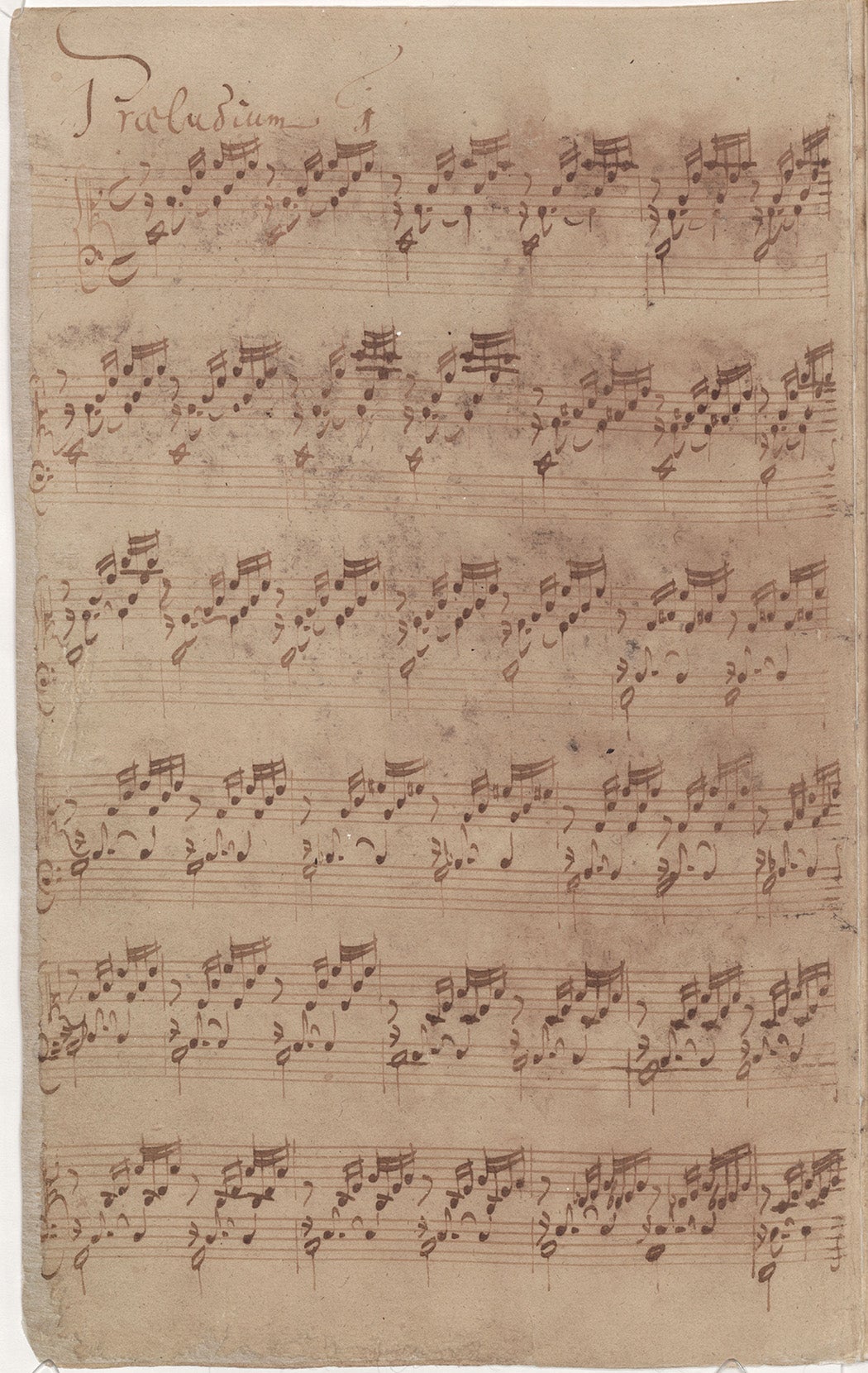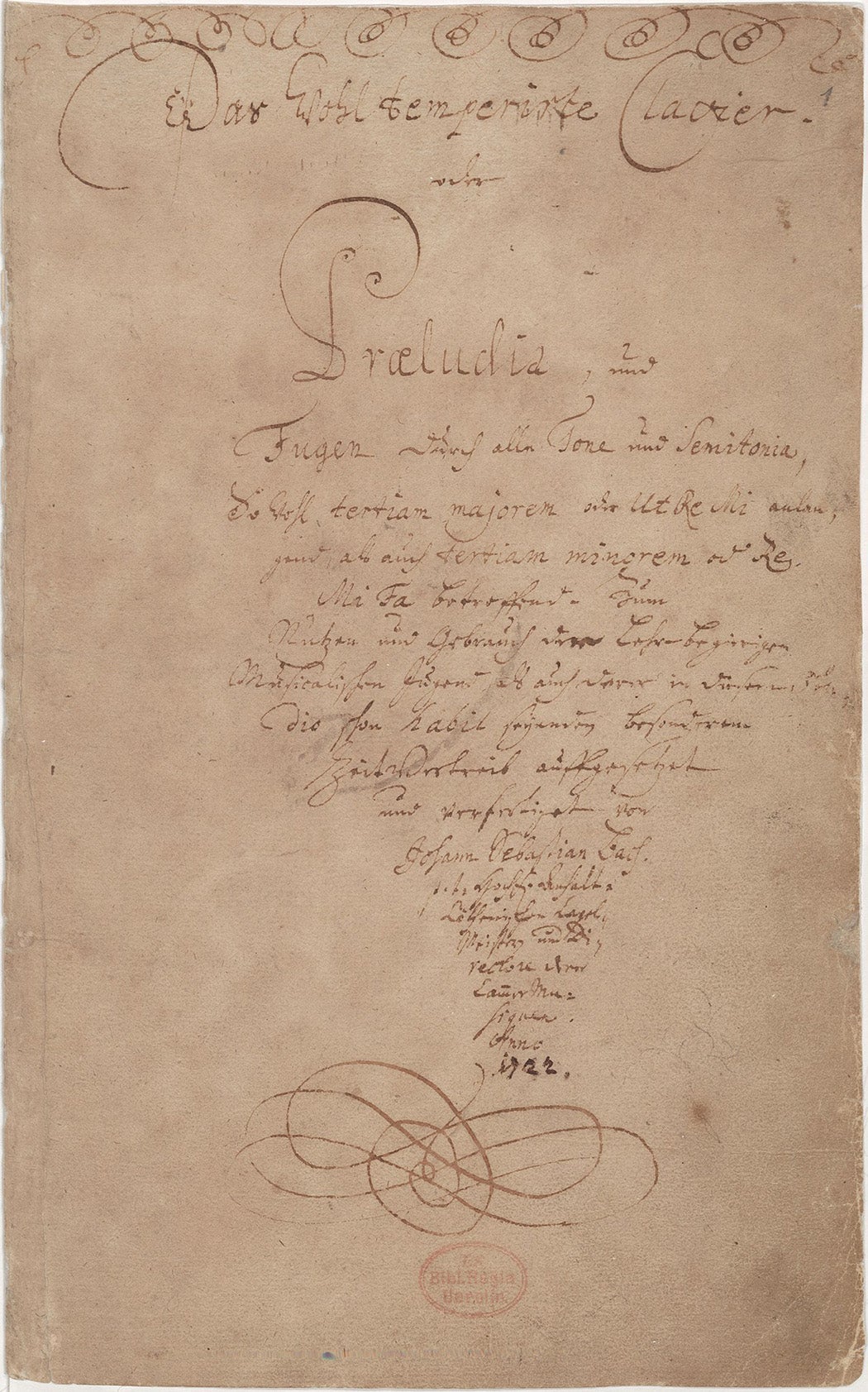This year marks the 300th anniversary of J. S. Bach’s The Well-Tempered Clavier, the most audacious and influential volume of music ever written for keyboard. Even if you’re not a diehard baroque fan, you’ve no doubt heard selections from The Well-Tempered Clavier in the background of your life—in movies scores, at Starbucks, and choppy iterations through the wall as the neighbor kid practices her piano lesson. You’ve also heard it remixed by other composers. The famous “Ave Maria,” a meditation on The Well-Tempered Clavier’s opening piece, the Prelude in C Major, was penned by French composer Charles Gounod a hundred years after Bach’s death. The theme was repurposed yet again by Yo-Yo Ma and Bobby McFerrin in the 1992 album Hush. Or maybe you’ve heard the opening of Lady Gaga’s 2009 hit “Bad Romance,” which quotes the final piece in the book, the Fugue in B minor.
The Well-Tempered Clavier is a set of preludes and fugues, that is, forty-eight short pieces in all twenty-four keys, major and minor. Although these pieces are regularly performed in professional settings, Bach originally presented his collection as a pedagogical work for advanced students, “for the profit and use of musical youth desirous of learning, and especially for the pastime of those already skilled in this study,” as he wrote on the title page for Book One, which he completed in 1722. Twenty years later, he wrote a second complete set of preludes and fugues in all keys, Book Two. Both volumes were hand-written, hand-copied, and widely circulated during Bach’s lifetime, but they weren’t published in printed form until fifty years after his death.
What’s so “well-tempered” about this clavier? And, what’s a “clavier,” in the first place? Is it a sort of old-fashioned piano on Prozac? If you’ve been wondering, you’re in good company. For more than a century, early music specialists have been sparring over these very questions. The second is easier to answer than the first: Over the years, partisans for various ancient keyboard instruments have tried to claim The Well-Tempered Clavier for themselves, including the Italian composer Ferruccio Busoni, who misnamed the collection “’Das Wohltemperierte Clavichord,” and the famous twentieth-century Polish harpsichordist Wanda Landowska, who insisted the pieces were meant for her instrument, only. There’s now consensus that when Bach wrote “Das Wohltemperirte Clavier,” he meant “clavier” to signify any musical keyboard—harpsichord, clavichord, organ. He did not mean the modern piano as we know it, the very instrument upon which The Well-Tempered Clavier is played most often now, because modern pianos had yet to evolve. (More on that later.)

As for what Bach meant by “well-tempered”— a clue is in the structure of the volume. To modern sensibilities, a systematic book for aspiring keyboard students seems like a sensible pedagogical project sprung from an orderly mind: start in C major with prelude and fugue. Next, a prelude and fugue in the parallel key, C minor. Then C# major and minor, then D and so forth, all the way through B minor. As they work their way through the book, students practice all the key signatures sequentially. Indeed, that’s how the book functions today for contemporary concert pianists and students of piano. But the simplicity of the concept belies the audacity of its origin. While completely playable on modern pianos, The Well-Tempered Clavier would have been impossible to perform on keyboards of Bach’s time—not without a radical new approach to tuning the very instruments it was written for.
Weekly Newsletter
To understand why the manuscript was so revolutionary back in 1722, and why 300 years later it continues to foment controversy among baroque music aficionados, we need to keep in mind that the baroque keyboards were tuned differently than today’s pianos. If you fancy a deep dive into the physics of music, check out the links below; you will not be disappointed. For the rest of us, in simple terms, the drama comes down to an unsolvable problem of math. Imagine the twelve tones of a true chromatic scale as clock, or maybe an oozy pizza, in which twelve slices almost, but don’t quite fit.
As Ross Duffin writes in his chapter “Tuning and Temperament” in Jeffery Kite-Powell’s A Performer’s Guide to Renaissance Music:
We speak of the “circle of fifths,” that procedure whereby, starting on any note and going up or down in series by the interval of a fifth, eventually we arrive at a note with the same name as the one we started on. The problem is that if we tune fifths that are acoustically pure, the note we arrive at after a circle of twelve fifths will be about one quarter of a semitone sharp to the starting note. […] So, although acoustically pure fifths and acoustically pure major thirds would seem to be desirable sonorities to have in performance, there is no way that either one of them can be completely reconciled to the twelve available pitches of the keyboard octave. Either we tune eleven perfect fifths and leave the last one dissonant and unusable, or we compromise the perfection of the fifths and create what is known as a temperament.
The ancient system known as Pythagorean intonation uses mathematically pure fifths and thirds, as described above by Duffin. For vocalists and for instrumentalists such as violinists and trombonists, who can adjust their intonation on the fly, this intonation produces a sweet, pure sound in the melodic line. Players get into trouble when harmonizing and need to narrow intervals to stay in tune. When you add a keyboard to the mix, everything goes sideways because keyboard players aren’t able to continually adjust their intonation. Modern keyboards use a tuning that smooths out the bumpy edges of the pizza by diving the pie into twelve equal slices. In this system, known as “equal temperament,” every interval is a little out-of-tune, but nothing sounds too horrible. In other words, no more overlapping cheese and anchovies; instead, a pizza that is a little less pure.
As Ll. S. Lloyd wrote in his article “The Myth of Equal Temperament” in Music & Letters (1940):
All musicians know that equal temperament is an acoustical compromise, tolerated by many ears on the piano, and designed to satisfy as completely as possible three incompatible requirements—true intonation, complete freedom of modulation and convenience in practical use in keyed instruments—and that it sacrifices the first of these to the second and third.
Today, when instruments or vocalists perform with piano accompaniment, they adopt the piano’s intonation. We’ve lived with equal temperament for so long now that our modern ears can barely register the imperfections of equal-tempered intervals—it sounds normal to us. Equal temperament may be a compromise, but it has freed composers and keyboard players to modulate into any key they wish without sending their audiences running for the exits.

In Bach’s time, the conventional workaround for tuning keyboards was known as “mean-tone” tuning, a system that adjusted certain intervals by nudging pitches closer together. With mean-tone tuning, it became possible for keyboard players to play in different keys. One attractive feature of the system is that each key is imbued with a distinctive emotional character, allowing the composer an additional layer of artistic sensibility: C major sounds cheerful; C minor, tragic; F major, relaxing. But the problem with mean-tone tuning is that some keys are irredeemably, nails-on-chalkboard intolerable (A flat and E flat.) Composers in Bach’s time simply avoided using those keys. That’s why, in the music world of 1722, an instruction book showcasing sequential pieces in each successive key was a shocking development.
For years, many scholars argued that by writing The Well-Tempered Clavier Bach was advocating the use of equal temperament over mean temperament—how else were performers expected to play through these volumes? Others argued, no, Bach wasn’t the type to impose such a rigid, imperfect system on his students, let alone future generations.
As Lloyd wrote, pitting the dread soulless “theoretician” against a musically imaginative composer:
To suppose that by so doing he established a false foundation for all later occidental music is to ignore all the lessons of musical history, and to imagine that scales came first and music afterwards. Had some supreme authority abolished all keyboard instruments from the earth in the sixteenth century and ever after, composers writing for voices, strings or the orchestra would have made music from which we could distil [sic] the same flexible scale-system, with its use of enharmony, as we discover in their compositions to-day. Bach imposed no tyranny on the intonation of a later music. On the contrary he re-asserted its right to freedom of intonation, and he tuned his clavichord to express his music imagination as well as it could. Only the “theoretician”, thinking in terms of physical vibrations and a rigid scale, i.e., a “tuning” not a musical scale, can reach any other conclusion.
In 2005, independent scholar and harpsichordist Bradley Lehman rocked the early music world with a two-part article published in the February and May issues of Early Music. In the first part, Lehman pointed to the long-overlooked curlicue atop Bach’s handwritten title on Book One of The Well-Tempered Clavier, postulating that, much more than just a decoration, it was a diagrammatic key to the tuning Bach proposed for the instrument, the tuning that would make The Well-Tempered Clavier playable without flattening the emotional resonance of its individual keys. Book One was made public during a year when Bach had applied for a teaching position in Leipzig, and Lehman suggests it was created as a set of written audition materials for the position. Bach was known to verbally instruct his students with hands-on demonstrations; the diagram serves as a crib sheet. “To learn Bach’s tuning in his absence,” wrote Lehman, “all one has to do is make a handwritten copy of the drawing (analogous to copying out pieces of music)…” The key at the top of the page, overlooked for centuries by scholars as a mere doodle, is the key to “well tuning,” a temperament that is neither “mean” nor “equal.”

In the second part of his article, Lehman describes Bach’s new temperament as “an extraordinary blend of notes from three different sets, like carefully blended spirits…a unification of traditional mean-tone principals…equal temperament…and the ancient Pythagorean tuning of pure fifths.” When Lehman published his theory seventeen years ago, he generated heat from everyone—scholars who advocated the idea of Bach’s work as written for equal temperament, those who favor mean temperament, and those with the position that we can never know Bach’s mind.
The controversy is lively, but it’s not what keeps the music alive. The music is its own life. As Lehman writes, “Art is not merely the avoidance of error-dodging any hazardous intervals or chords—but the positive demonstration of significant truths.” Testing out Bach’s system of well-temperament on his own instrument, Lehman deepens his personal experience as a harpsichordist. His performance becomes simpler and more “right-brained” as he listens and reacts to the direction the notes take due to their expressive intonation. Playing in well-temperament, the performer channels Bach.
But what of the rest of us who are stuck with modern ears, listening to and playing on instruments that are equal-tuned? Lehman urges us to spend some time with Bach’s music set in the intonation that he believes Bach intended. “Other tonal music than Bach’s also sounds stronger now [after experimenting with well-temperament], so warm and full of character,” he writes. For those of us who don’t own and tune our own harpsichords, that will mean searching out recordings on YouTube or elsewhere. Listening in this new way may change the way we hear our modern world.







